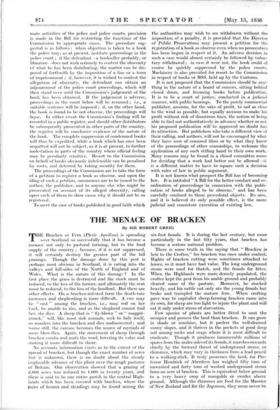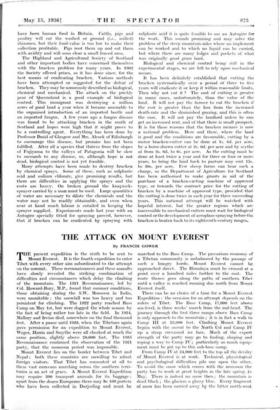THE MENACE OF BRACKEN
By SIR ROBERT GREIG
THE Bracken or Fern (Pteris i..1quilina) is spreading over Scotland so successfully that it has become a menace not only to pastoral farming, but to the food supply of the country ; because, if it is not suppressed, it will certainly destroy the greater part of the hill grazings. Though the damage done by this pest is perhaps most obvious in Scotland, it is eating into the valleys and hill-sides of the North of England and of Wales. What is the nature of this damage. ? In the first place the grass is destroyed and the stock must be reduced, to the loss of the farmer, and ultimately the-rent must be reduced, to the loss of the landlord. But there are other effects. On a bracken-infested farm the death-rate increases and shepherding is more difficult. A ewe may be " cast " among the bracken, i.e., may roll on her hack, be unable to rise, and as the shepherd cannot find lter, she dies. A sheep that is " fly-blown " or " maggot- struck," will, like most sick animals, seek to hide itself, so wanders into the bracken and dies undiscovered ; and worse still, the carcase becomes the source of myriads of more blow-flies. Again, the movement of sheep through bracken combs and mats the wool, lowering its value and making it more difficult to shear.
No accurate information exists as to the extent of the spread of bracken, but though the exact number of acres lost is unknown, there is no doubt about the steady implacable advance of this plant over the rough pastures: of Britain. One observation showed that a grazing of 2,000 acres was reduced to 1,000 in twenty years, and there is said to be one entire parish in the central High- lands which has been covered with bracken, where the ruins of houses and steadings may 'be found among the six-foot fronds. It is, during the last century, but more particularly in the last fifty years, that bracken has become a serious national problem.
There is some truth in the saying that " Bracken is heir to the Crofter," for bracken was once under control. Rights of bracken cutting were sometimes attached to leases, so it must have had value. The long underground stems were used for thatch, and the fronds for litter. When the Highlands were more densely populated, the crofter kept the pest from his arable ground and probably cleared some of the pasture. Moreover, he stocked heavily, and his cattle not only ate the young fronds-but broke and trampled the mature fern. When crofting gave way to capitalist sheep-farming bracken came into its own, for sheep are too light to injure the plant and will eat it only under stress of starvation.
Few species of plants are better fitted to oust the occupier and possess the land than bracken. It can grow in shade or sunshine, but it prefers the well-drained sunny slopes, and it thrives in the pockets of good deep soil among rocks and crags where it is most difficult to eradicate. Though it produces innumerable millions of spores from the under sides of its fronds, it marches onwards chiefly by the forward thrust of underground stems, or rhizomes, which may vary in thickness from a lead pencil to a walking-stick. It truly possesses the land, for Pro- fessor Hendrick of Aberdeen has weighed fifty tons of unwashed and forty tons of washed underground stems from an acre of bracken. This is equivalent below ground to a very heavy crop of mangolds or swedes above ground. Although the rhizomes are food for the Maories of New Zealand and for the Japanese, they seem never to have been human food in Britain. . Cattle, .pigs and poultry will eat the washed or ground (-i.e., milled) rhizomes, but their food-value is too low to make their collection profitable. Pigs root them up and eat them with avidity and will soon clear a small fenced area.
The Highland and Agricultural Society of Scotland and other important bodies have concerned themselves with the bracken problem for many years. In 1902 the Society offered prizes, as it has done since, for. the best means of eradicating bracken. Various methods have been attempted or suggested for the defeat of bracken. They may be sonorously described as biological, chemical and mechanical. The attack on the prickly pear of Queensland is a good example of biological -control. This immigrant was destroying a million acres of good land a year when it became amenable to the organised introduction of an imported beetle and an imported fungus. A few years ago a fungus disease was found to be attacking bracken in the south of Scotland and hopes were high that it might prove to be a controlling agent. Everything has been done by Professor Braid of Glasgow and Mrs. Alcock of Edinburgh to encourage this disease, but promise has not been fulfilled. After all a species that thrives from the slopes of Fujiyama to the valleys of Patagonia will be slow to succumb to any disease, so, although hope is not dead, biological control is not yet feasible.
Many attempts have been made to destroy bracken by chemical sprays. Some of these, such as sulphuric acid , and sodium chlorate, give promising results, but there are difficulties in applying the sprays and the costs are heavy. On broken ground the knapsack- sprayer carried by a man must be used. Large quantities of water are necessary 'to dilute the chemicals and the water may not be readily obtainable, and even when near at hand much labour is entailed in keeping the sprayer supplied. Experiments made last year with an Autogiro specially fitted for spraying proved, however, that if bracken can be eradicated.. by spraying with sulphuric acid it is quite feasible to use an Autogiro for the work. This sounds promising and may solve the problem of the steep mountain-sides where no implement can be worked and to which no liquid can be carried, but where there are many ledges and pockets of what was originally good grass land.
Biological and chemical control being still in the experimental stages, we are left to rely upon mechanical means.
It has been definitely established that cutting the bracken systematically over a period of three to five years will eradicate it or keep it within reasonable limits. Then why not cut it ? The cost of cutting is greater in many cases, unfortunately, than the value of the land. It will not pay the farmer to cut the bracken if the cost is greater than the loss from the increased death-rate and the diminished grazing, and this is often the case. It will not pay the landlord unless he can get an increased rent, and of that there is small prospect. It is for these reasons that the bracken menace is now a national problem. Here and there, where the land is good and the conditions are favourable, cutting by a motor bracken-cutter can be done at ls. Od. per acre, by a horse-drawn cutter at 2s. ad. per acre and by scythe at from 2s. ad. to Os. per acre. As the cutting must be done at least twice a year and for three or four or more years, to bring the land back to pasture may cost 15s. to 30s. per acre. Few sheep farms can bear such a charge, so the Department of Agriculture for Scotland has been authorised to make grants in aid of the purchase of a bracken-cutting machine of approved type, or towards the contract price for the cutting -of bracken by a machine of approved type, provided that the cutting is done twice in each year for three succeeding years. This national attempt will be watched with hopeful interest, but the greater regions which • arc inaccessible to mechanical cutters must wait for biological control or the development of aeroplane spraying before the bracken is beaten back to its eighteenth-century ranges.























































 Previous page
Previous page